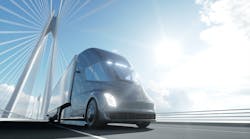When fleets succeed or fail based on operating costs calculated at fractions of a penny per mile, unknowns in the spreadsheet are a big problem. And, based on formal and informal discussion at the recent ATA Management Conference & Exhibition, those unknowns are tempering many truckers’ enthusiasm for electric vehicles.
The good news: Most folks I spoke with are fans of the vehicles themselves, or at least see the potential based on some test drives and demonstration runs. But many aspects of fueling an alt-fuel vehicle have yet to be determined, and you can’t run a fleet on good intentions.
So the conference room was full for the MC&E Sunday morning panel to discuss battery-electric and hydrogen fuel cell trucks. As it turned out, the presentations were just a warm-up for an extended Q&A with members of the audience. And everyone was late for lunch.
“Our world is changing. We are embarking on a monumental shift to new technologies that will upend the 125-year history of single source energy,” Rakesh Aneja, vice president of eMobility at Daimler Truck North America, said. “We are at the tipping point of forever changing commercial transportation and, with it, our world—if, or rather I should say, when we can overcome the challenges to get there.”
See also: Fleets 'frustrated' with utilities slow to support electric truck charging
Among the challenges, Aneja emphasized the importance of matching these new truck technologies to suitable applications. And, currently, those applications are limited because the charging/fueling infrastructure is limited.
“Developing the infrastructure and overcoming the challenges of the grid, specifically for commercial transportation, will be our focal point for the next several years,” Aneja said. “We cannot rely on the passenger car infrastructure charging network to recharge our trucks.”
Grid upgrades
But, as we’re learning, the transition to commercial EVs depends heavily on the ability and willingness of utility companies to get ahead of demand—something, historically, they’re not prepared to do.
“To upgrade the electric grid is essentially a social cost. Each utility and public utilities commission across the country is going to do it differently,” explained Bill Zobel, director of alternative fuels at Pilot Co.
And that means fleets could gain, or lose, competitive advantage, based on who is providing the charging infrastructure.
“So how those costs manifest themselves in the total cost of ownership for the truck at the end of the day remains to be seen,” Zobel said.
As for hydrogen, Zobel suggested private capital will fund the infrastructure, and investors will need returns—but private capital is accustomed to risk and not constrained by regulators.
“So there's a big difference between the way those two those two infrastructure models will play out over time," Zobel said.
The appeal of hydrogen, he explained, is the supply chain is much like petroleum.
“In other words, it's centrally produced at a plant. It's distributed on a truck to a retail location where it's sold to the customer,” Zobel said. “So the business model is very similar: There are select points in the value chain where money can be made, investments can be made, to help move the market forward. So in that regard, it becomes very simple. The fueling for hydrogen is very quick; you can fuel a truck in 10 minutes or less, get them in and out just like you do with a petroleum experience.”
Zobel also noted the federal government has recently made a large investment in a hydrogen production program, and offers incentives to support clean hydrogen.
TMC Technical Director Jack Legler, who moderated the panel, laid out the math.
“Basically, we use 14 terawatts of energy per year to move our Class 8 trucks,” Legler said. “It doesn't matter what form that energy is, and whether it's diesel, gasoline, hydrogen, pure electric, whatever. It's still 14 terawatts of energy—and that represents approximately 5% of the national grid capacity from an electric standpoint.”
The solutions are available, but “a different way of thinking” will be required for the transition away from fossil fuels.
“The partnerships that you're going to have to make are going to be businesses that we traditionally have not partnered with before—and everybody is learning about each other's needs and capabilities,” he said.
More questions
Of course, truckers are a tough crowd. Several in the audience wanted to know just how much of a net benefit this transition to alternative fuels was really going to provide, especially if the power requirements can’t be met by renewable fuels, or if the battery technology means costly mining for materials or causes problems when the batteries are no longer useful.
Legler, who has worked in waste management, noted that recycling, initially, “was not as environmentally friendly as everybody made it out to be—which is why it evolved to what it is today from what the original regulatory construct was,” he said. “Because once operational reality sticks its ugly nose in the middle of your theory, it kind of changes things.”
See also: Slow and steady wins the race to zero emissions
And Aneja agreed on the importance of “a lifecycle assessment,” and he noted that manufacturing and operating a Freightliner eCascadia reduces carbon emissions by about 50%, based on the current power generation mix in the U.S. With a clean energy supply, however, the reduction would be 95%.
“And to me, it's an absolute given: It has to come from renewable energy, otherwise we're just shifting the issue,” he said.
Mike Roeth, executive director at the North American Council for Freight Efficiency, noted the lifecycle values can be determined, but fleets should simply continue to focus on running efficiently.
“That becomes one hell of a huge spreadsheet calculation, with a lot of variables—that's very complex to do,” Roeth said. “But somebody has to do it, and all the rest of us need to work on the individual parts of those equations to make all this work.”
While it’s important to understand the big picture, folks in the audience wanted details—or specifically: “Where’s the data?”
And that’s the problem with something new: There’s not much data out there. But assessing the value of new truck technology is what NACFE does.
“Good data, that will satisfy lot of us in the room, comes with time,” Roeth said. “We just have to operate these trucks. We’ve got to learn from them. It’s going to take time to build them, run them, understand them—and they're going to improve dramatically. We are in the very early stages of understanding what a battery electric truck is.”
“Everybody's going to be learning again,” Legler added. “Everything in the vehicle ecosystem affects everything else. We'll learn quickly with the more vehicle miles we accumulate on all of these technologies.
“The learning curve is very steep.”






